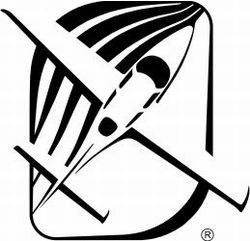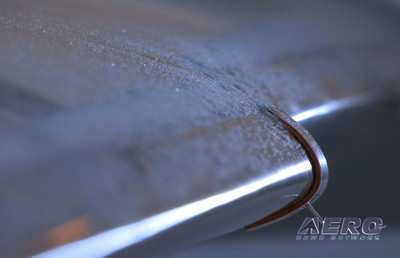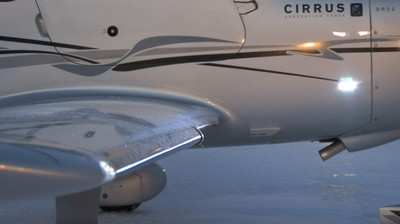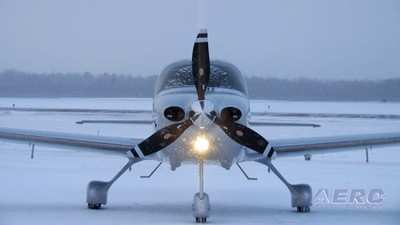FAA Approval Expected In Q2 2009
 Cirrus Aircraft has
officially taken the wraps off its new "Known Ice Protection"
option for Cirrus SR22 and Turbo models. Aircraft are available for
sale now, with FAA certification for operations in known icing
conditions expected in Q2 of 2009.
Cirrus Aircraft has
officially taken the wraps off its new "Known Ice Protection"
option for Cirrus SR22 and Turbo models. Aircraft are available for
sale now, with FAA certification for operations in known icing
conditions expected in Q2 of 2009.
In a Monday teleconference, Cirrus Chairman Alan Klapmeier said
"Known Ice Protection completes the picture for many when it comes
to reliable, personal transportation. It can allow operations on
marginal weather days when icing forecasts would otherwise preclude
travel. This means a Cirrus customer gets more utility and
ultimately more capability from their airplane investment."
Klapmeier continued, "An important issue to address up front is
although the airplane has completed testing to show its safe to fly
in FAA known icing conditions, no one should ever think that this
means they can drone along impervious to nature in icing conditions
— nature always wins! Of course proper training and decision
making is essential for flight safety."
Developed in partnership with CAV Ice Protection Ltd., the
Cirrus SR22 and Turbo Known Ice Protection system has
CAV’s fully integrated TKS “weeping wing”
technology in laser-drilled panels on the leading edges of wings,
horizontal and vertical tail surfaces and elevator. Dual pumps
provide the power needed to distribute the fluid throughout the
airframe.
New high-intensity LED ice lights on both sides of the airplane
illuminate wing leading edges and tail surfaces through a unique
prism lens. An automotive-style de-icing system distributes TKS
fluid evenly onto the windshield, and a traditional slinger-ring
affords ice protection for the propeller and other remaining
exposed surfaces.

The Cirrus Known Ice Protection system integrates with
Cirrus Perspective (by Garmin) on 12-inch screens by
displaying key operating and system status information on the MFD.
TKS fluid capacity of up to 8 gallons maximum and various pilot
selected flow rates allows de-icing fluid flow for up to 2.5
hours. If fluid levels run low, Cirrus Perspective will display
cautions and increasing warnings.
Ian Bentley, Vice President of Products and Services added,
“This is probably the most extensively tested known-ice
package ever developed for general aviation. The Cirrus Known Ice
Protection certification program had the same icing envelope and
followed similar testing protocols as airliners
under FAR Part 25.”
Cirrus indicated testing of the system for FAA certification was
largely complete, though formal approval has not yet been
granted.

Sensitive to potential backlash from the GA community
about the safety of single-engine piston planes operating in
known icing, FIKI approval or not, the company also added
a caveat to anyone who would assume FIKI meant imperviousness to
Mother Natue.
“Known Ice Protection approval does not create an
‘all weather’ airplane, a perhaps overused term in
aviation. Even airliners and corporate aircraft cancel flights for
weather – particularly winter weather. A broad knowledge of
weather operations and flight experience in your Cirrus is always
necessary.”
In a disappointing, -- though perhaps not surprising --
concession, Cirrus admits earlier hopes the company's eventual FIKI
solution would be retrofittable throughout the existing fleet (or
at least on Perspective-equipped planes, or planes eqipped with
anti-icing systems) will not come to pass.

Klapmeier notes the indents in the leading edges of the
composite wing, horizontal stab and vertical stab skins for the TKS
panels are unique for full-FIKI planes, and the Perspective
avionics suite is the only panel that includes the monitoring
system.
 Aero-News: Quote of the Day (04.28.25)
Aero-News: Quote of the Day (04.28.25) ANN's Daily Aero-Term (04.28.25): Decision Altitude (DA)
ANN's Daily Aero-Term (04.28.25): Decision Altitude (DA) ANN's Daily Aero-Linx (04.28.25)
ANN's Daily Aero-Linx (04.28.25) Airborne-Flight Training 04.24.25: GA Refocused, Seminole/Epic, WestJet v TFWP
Airborne-Flight Training 04.24.25: GA Refocused, Seminole/Epic, WestJet v TFWP Aero-News: Quote of the Day (04.29.25)
Aero-News: Quote of the Day (04.29.25)






